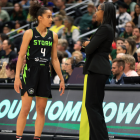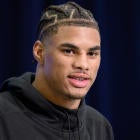If the 2019 NFL Draft had several first-round prospects at tight end, the 2020 class will be lucky to have one go in the first 32 picks. There are no T.J. Hockensons or Noah Fants (Hockenson went eighth overall to the Lions, Fants went 20th to the Broncos), and there may not even be an Irv Smith Jr. (he went 50th to the Vikings), at least in terms of athleticism, blocking and playmaking abilities. But you also shouldn't sleep on this group; there are the traditional inline tight ends, the move tight ends who play more like wide receivers, and the blockers who can be a force in the run game. The primary difference, however, is that they're in short supply. Put another way: If a team desperately needs one (Hi, New England Patriots!) they may have to take one earlier than expected.
That's isn't necessarily a bad thing; Travis Kelce was a third-round pick and George Kittle somehow lasted until Round 5. Put another way: Just because a tight end doesn't go in the first round doesn't mean he's destined for mediocrity. With that in mind, let's take a look at the top tight ends in the 2020 NFL Draft class.
Tier 1
Cole Kmet, Notre Dame
At one point during the season, it looked like Kmet would return to Notre Dame for 2020, but he announced in January his intentions to head to the NFL and with that announcement he very well could become the first tight end selected. The question becomes how high can he go? He's a level below Hockenson and Fant, and if we're comparing him to either, he's more like Hockenson. Kmet is an inline tight end who excels at blocking but he has the athleticism of a wide receiver and he's been known to also line up in the slot or at H-back.
Kmet is a crisp route runner and is tough to bring down once he makes the catch. He didn't run many deep routes at Notre Dame but he is more than capable of making plays downfield.
Hunter Bryant, Washington
If Cole Kmet is a more traditional tight end, Hunter Bryant is an athlete who happens to be listed at tight end. He can line up anywhere -- inline, slot, H-back, out wide -- and in many ways reminds us of Evan Engram. He's not a great blocker, but that's not why you would draft him, either. But Hunter does run really good routes and has the speed to beat linebackers and even safeties down the field. Drops are the biggest red flag -- he dropped 9.7 percent of the catchable targets last season, according to Sports Info Solutions. Those drops appear to be focus-based and not from some inherent flaw in how he catches the football. Still, unless Bryant can convince NFL teams that he can be more consistent in that area, he'll likely slip in the draft.
That said, he has game-changing skills and you saw that often during the 2019 season when he was on the receiving end of 52 Jacob Eason passes and averaged an impressive 15.9 yards per reception.
Adam Trautman, Dayton
Adam Trautman is the only FCS player on this list and by the time it's all said and done, he could be the first tight end drafted. He dominated the competition at Dayton and did the same when he showed up to the Senior Bowl in January. Typically, that week can go one of two ways for small-school prospects: They can be overmatched and struggle to compete, or they can raise their game to meet the competition. Trautman fit in from Day 1 at the Senior Bowl and if you had told us he spent the last three years playing in the SEC we would've believed you. He can line up anywhere but he's also a tenacious blocker. Trautman is a physical route runner in that he uses his hands well at the line of scrimmage, and at top of his routes, to facilitate separation. He has good speed for his 6-5, 250-pound frame and the biggest issue facing him now will be how he makes the transition from FCS to the NFL. Again, if the Senior Bowl is any indication, it won't be a problem. At all.
Tier 2
Harrison Bryant, FAU
If there's a recurring theme with this group is that they can line up just about anywhere. The same holds true for Bryant, an athletic tight end who can play along the line of scrimmage, in the slot and at H-back. He's a willing blocker but lacks the size to do it consistently -- in fact, he moves more like a smaller, quicker receiver than a 6-4, 242-pound tight end. He averaged 15.4 yards per reception last season, and 18.2 percent of his receiving yards came after contact, according to Sports Info Solutions. Bryant dropped 10.8 percent of his catchable targets in 2019 after not having issue with drops the year before. He had a strong showing at the Senior Bowl but he'll also need to run well at the combine to convince NFL teams he has the speed to play the position, especially since he won't be drafted because of his blocking prowess.
Brycen Hopkins, Purdue
Athletically, Brycen Hopkins fits the mold of today's NFL "move" tight end. In terms of consistency, he's been something less than that during his college career. He has soft hands and is a smooth route runner ... but (you knew it was coming) he struggles with drops. Last season, he dropped 11.5 percent of his catchable targets and that will be a non-starter for many NFL teams in the early rounds. In fact, according to Pro Football Focus, Hopkins' 22 drops since 2016 are eight more than any other tight end in this draft class. He's also not much of a blocker, which again limits what he can do at the next level. That said, he's great with the ball in his hands, has the ability to break tackles and is a legit deep threat. In the right system, one where he's the third or fourth option, Hopkins can be a matchup problem for opposing defenses because of his speed and highlight-type abilities.
Jared Pinkney, Vanderbilt
Jared Pinkney would've been better served turning pro after the 2018 season when he had 50 receptions for 774 yards (15.5 YPC) and seven touchdowns. His 2019 campaign was, by any measure, disappointing; he finished with just 20 catches for 223 yards (11.7 YPC) and two touchdowns. Yes, he played five fewer games but the production, even on a per-game basis, just wasn't there. Part of that was the change at quarterback, and NFL teams certainly understand as much. At 6-4, 254 pounds, Pinkney looks the part, and even though he lines up mostly on the line of scrimmage, blocking is not his strong suit (though he is a willing participant). That said, he's surprisingly fast for his size and has a knack for getting open on short and intermediate routes.
Tier 3
Albert Okwuegbunam, Missouri
Albert Okwuegbunam, like Pinkney, might have been better served coming out after the 2018 season. He had 43 receptions for 466 yards (10.8 YPC) and six touchdowns with Drew Lock as his quarterback. Last season, with Kelly Bryant, Okwuegbunam's numbers were 26 catches, 306 yards (11.8 YPC) and six touchdowns. He also had seven drops, which works out to a drop rate of 18.4 percent. At 6-5, 255 pounds, Okwuegbunam lines up inline, in the slot and at H-back, and shows the ability to be a consistent blocker. We'd like to see a little more urgency in his routes, and while he's not particularly explosive or quick, he has the strength to win at the catch point.
Thaddeus Moss, LSU
The son of Randy Moss, Thaddeus Moss was yet another beneficiary of Joe Brady's offense at LSU. (Joe Burrow, Justin Jefferson and Clyde Edwards-Helaire also earned themselves a lot of money in Brady's system.) The tight end transferred from NC State after the 2016 season, then missed the 2018 season because of a foot injury. But he was fully healthy in '19 and had 47 catches for 570 yards (12.1 YPC) and four touchdowns -- and in the process, became one of Burrow's most reliable targets. Not surprisingly, he has remarkable hands and if you need further proof, Moss dropped exactly zero passes last season on 51 catchable targets. He'll need to get better as a route runner and a blocker but he showed at LSU that in the right system he can be productive.
Cheyenne O'Grady, Arkansas
Cheyenne O'Grady might be one of the most talented tight ends in this class but his issues are off the field. He was suspended late in '19 season, missing the final three games. It was the second time O'Grady had been suspended by coach Chad Morris, including the first two games of the 2018 season. And O'Grady also was suspended by Morris' predecessor Bret Bielema back in 2015. On the field, O'Grady lines up inline, in the slot, out wide and at H-back. He looks effortless running his routes -- almost looks like he's gliding -- and he snatches the ball out of air. If he can stay out of trouble, O'Grady can be a contributor at the next level.
Stephen Sullivan, LSU
Stephen Sullivan is an interesting prospect, mostly because he had just 12 catches for 130 yards in six games during the 2019 season and parlayed that into a Senior Bowl invite where he very much looked at home playing tight end. Still, he didn't see much time in LSU's offense because of Moss, whose strong finish to the '19 campaign put him firmly in the draft conversation. Sullivan may have to make an NFL team as a special teamer but he's also a former wide receiver who could grow into the position.





















